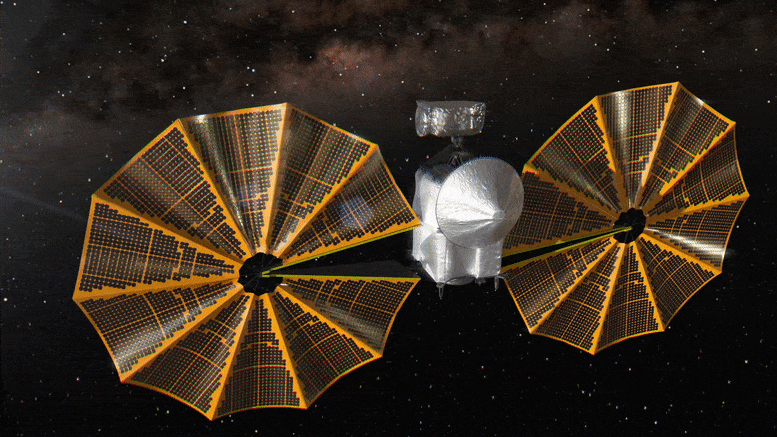NASA’s Lucy Team Completes Step One of Solar Array Deployment Fix
NASA’s Lucy spacecraft deploying its solar arrays. Credit: NASA’s Goddard Space Flight Center
On May 9, NASA’s Lucy team executed the first of two planned steps in its efforts to complete the deployment of the spacecraft’s unlatched solar array. This first step was time-limited and was intended to validate that the team’s ground testing adequately represented the flight system’s performance, rather than to latch the solar array.
The results are currently being analyzed to see if they are consistent with ground testing. The team will determine the next steps for the deployment effort after reviewing the data. The second step is tentatively scheduled for approximately a month after the first.
Launched on October 16, 2021, Lucy is the first space mission that will explore the Trojan asteroids. These are a population of small bodies that are left over from the formation of the solar system. They lead or follow Jupiter in their orbit around the Sun, and may tell us about the origins of organic materials on Earth. Lucy will fly by and carry out remote sensing on six different Trojan asteroids and will study surface geology, surface color, and composition, asteroid interiors/bulk properties, and will look at the satellites and rings of the Trojans. Credit: NASA’s Goddard Space Flight Center

NASA’s Lucy spacecraft deploying its solar arrays. Credit: NASA’s Goddard Space Flight Center
On May 9, NASA’s Lucy team executed the first of two planned steps in its efforts to complete the deployment of the spacecraft’s unlatched solar array. This first step was time-limited and was intended to validate that the team’s ground testing adequately represented the flight system’s performance, rather than to latch the solar array.
The results are currently being analyzed to see if they are consistent with ground testing. The team will determine the next steps for the deployment effort after reviewing the data. The second step is tentatively scheduled for approximately a month after the first.
Launched on October 16, 2021, Lucy is the first space mission that will explore the Trojan asteroids. These are a population of small bodies that are left over from the formation of the solar system. They lead or follow Jupiter in their orbit around the Sun, and may tell us about the origins of organic materials on Earth. Lucy will fly by and carry out remote sensing on six different Trojan asteroids and will study surface geology, surface color, and composition, asteroid interiors/bulk properties, and will look at the satellites and rings of the Trojans. Credit: NASA’s Goddard Space Flight Center
